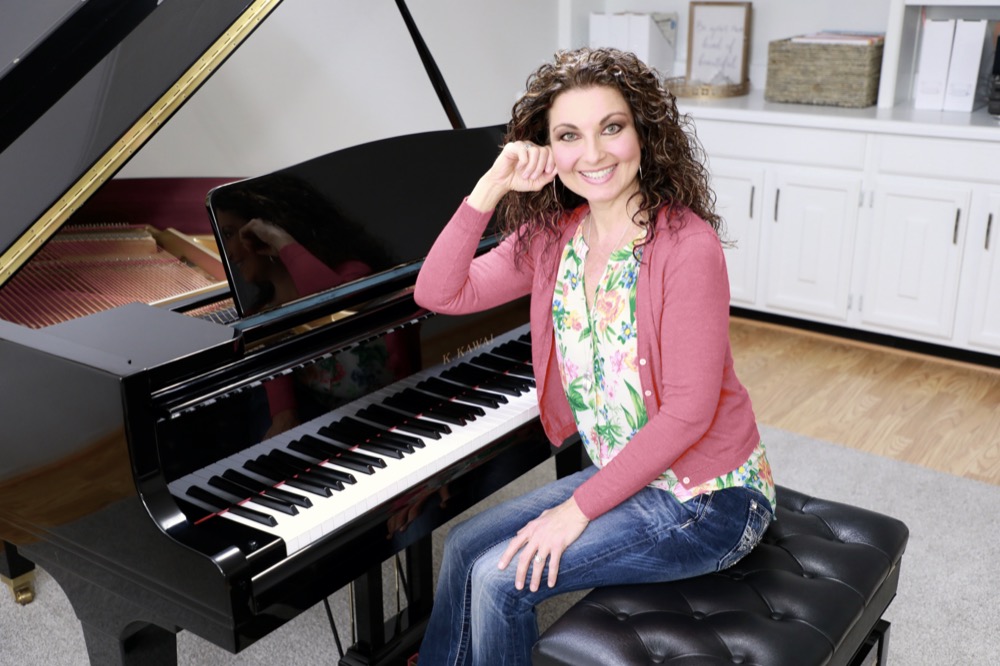5 Reasons to Include Collaboration in Your Piano Studio
This post may contain affiliate links. If you purchase something through an affiliate link, I will receive a small commission at no cost to you. For more information, read the disclosure statement here.

It can be hard to include collaboration in your piano studio, but in today’s guest post by Rachel Ehring, we’re going to see 5 reasons why it’s important!
We’ve all been there.
Alone in a practice room for hours practicing the same daunting passage over and over with only the metronome as our faithful companion.
For me it was in undergrad when I was learning Chopin’s Etude Op. 10, No. 4 and my piano teacher told me to practice each section at least 50-75 times.
Of course, this type of practice was necessary to conquer the daunting nature of the piece, but if that is all we know and all we teach our students, it can quickly lead to burnout.
Playing the piano can be a lonely art, but it doesn’t have to be!
Introducing collaboration in your piano studio to students of all ages is a way to improve both musical and non-musical skills that will create lifelong music lovers.
What exactly is collaboration at the piano?
It is simply any time that a pianist is playing with another musician.
We used to call this “accompanying” and that term is still used, but the term “collaborative piano” came into vogue around the 1980’s to show the equality of the two partners.
The pianist is not simply a backing track or a karaoke jukebox, but rather a living, breathing musician who is there to make beautiful music with his or her partner.
Collaborative piano can take many forms from 4-hand piano to accompanying a singer, instrumentalist, choir, or other ensemble.
In my career as an accompanist (personally, I don’t mind the term “accompanist”), I’ve had gigs playing for ballet classes, musical theater shows, choirs of all varieties, and of course hundreds of solo singers and instrumentalists.
I’ve had full-time accompanying positions, steady part-time work, and one-time gigs. And they have all contributed to making me a better musician and often a better person as well!
Introducing accompanying skills to your students by including collaboration in your piano studio might be easier than you thought.

Here are 5 reasons that collaboration is a great addition to your studio offerings.
1. Collaboration in Your Piano studio Improves rhythm
It is nearly impossible to collaborate without good rhythmic skills.
Students will make advancements in keeping a steady beat and will have to play rhythms accurately in order to stay with their partner.
If a student is struggling with rhythm or a steady pulse and you don’t think he or she is ready for collaboration, try playing duets together.
You can be the “rhythmic rock” while the student learns to keep a steady tempo and play accurately.
Of course, the metronome is good at being an unwavering partner, but playing duets as a way to add collaboration in your piano studio is much more fun!
2. Increase Listening Skills with collaboration in your piano studio
Collaboration will also improve listening skills.
As solo pianists, we become accustomed to only hearing the sound of the piano and focusing on our own part alone, but if you accompany a singer or instrumentalists, you have to listen to the whole of the music.
If you have students who are accompanying another musician, it is a great opportunity to discuss listening and texture.
Ask questions such as: Who has the melody? Does that ever change? Which of your hands has the more important part? What is the role of the piano?
You might also be surprised to see that if one partner is playing more musically than the other, the less musical partner will suddenly rise to the occasion become more musical without even realizing it!
3. Collaboration Increases motivation
Along with encouraging an increase in musicality, collaboration in your piano studio can increase a student’s motivation to practice and make music.
Knowing that they are going to be playing with another musician is similar to the motivation of an upcoming performance.
No one wants to be the “weak link” of the musical partnership, so students will work hard to learn the music and show up prepared. There is intrinsic motivation in not wanting to let their partner down.
4. Collaboration in your piano studio provides Future job opportunities
We can’t ignore that accompanying skills can translate into future job opportunities and income for our students.
We are doing them a disservice if we don’t train them in this area and also educate them about the opportunities that exist to earn money through accompanying.
We must let our students know that they don’t have to be the top 1% of piano players in the world to make money as a pianist.
There are singers, instrumentalists, and choirs in every state and country in the world who need a pianist to play with them and who will pay for that opportunity.
The list is long of potential incoming-producing opportunities for pianists who have good collaborative skills and is a vital reason to include collaboration in your piano studio.
5. Collaboration is fun!
Perhaps the greatest reason of all to include collaboration in your piano studio is that it is fun!
In the Conservatory where I am the Director, we have two students who take a buddy lesson together.
Every week, I know exactly when they arrive for their lesson because they come in with a flourish of giggles, talking and running up the stairs to get to their lesson.
The joy that they feel about their weekly buddy lesson is apparent to everyone in the building!
It can get tiresome practicing alone at the piano for hours and collaboration is a chance to make music with others and will provide a social element that is often missing from playing the piano.
Final Thoughts on Collaboration in your piano studio
Collaboration is a fantastic addition to any piano studio.
It can be as simple as playing duets with your students or as sophisticated as partnering with a studio of singers or instrumentalists to give your students the chance to accompany.
The logistics of collaboration in your piano studio can seem overwhelming at first, so I encourage you to start small.
Maybe you have students who can accompany a sibling or family member. Perhaps a student in your studio also sings or plays another instrument and would be willing to collaborate with fellow students.
The rewards of teaching your students how to collaborate and giving them the skills to do so will far outweigh the logistical issues.
Your students will be better musicians and will have skills that they can take with them into the future to earn money and make music with friends for a lifetime.
Do you include collaboration in your piano studio?
Comment and share your experience! What are your students’ favorite ways to collaborate? How do you include collaboration in your piano studio?
Keep Reading!
Here are more blog posts to enhance your teaching!
Don't miss out!
Follow on Facebook and Instagram, join the best Facebook group for piano teachers, and subscribe to the newsletter to get helpful teaching tips, resources, and tutorials delivered straight to your inbox every week.
Rachel Ehring
Rachel Ehring
Welcome!

Hi! I’m Melody Payne, a pianist and piano teacher, educational resource author, a fun-loving wife to the most wonderful and talented hubby I could ask for, and a lifelong learner who loves to share. I want to make your life as a music teacher easier by writing and sharing helpful and relevant music teaching articles, and by creating educational resources with your very own students in mind. If you are a parent who wants to enroll your child in piano lessons, I’d love for us to get started building those skills that can give your child a lifetime of musical enjoyment!

